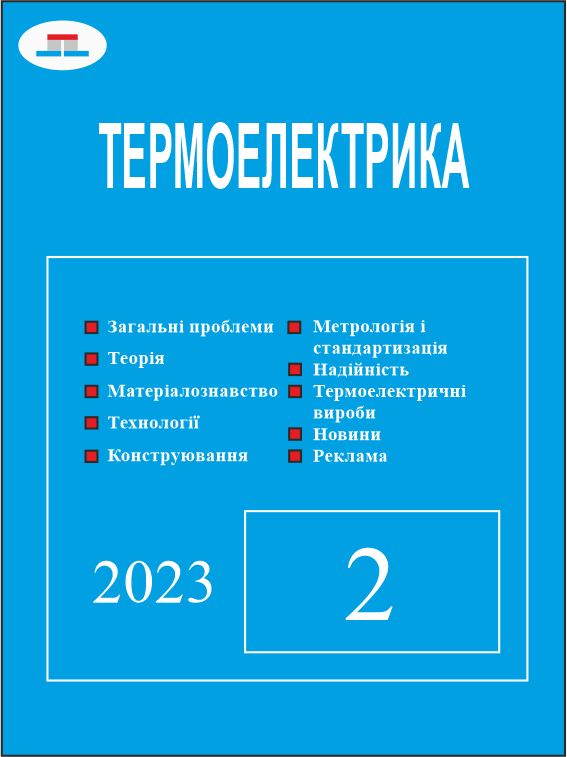Імовірнісна теорія деградації термоелектричних перетворювачів енергії та її використання для визначення надійності термоелектричних матеріалів
Ключові слова:
ймовірнісна теорія деградації термоелектричних перетворювачів енергії, Граничний ресурс термоелектричного перетворювача енергії, середній граничний ресурс термоелектричних матеріалів, 95 % граничний ресурс термоелектричних матеріалів, мінімальна досяжна еквівалентна інтенсивність відмов, відносні похибки їх визначенняАнотація
Розроблено імовірнісну теорію деградації термоелектричних перетворювачів енергії яка описує такі етапи їх життєвого циклу, як період припрацювання, який описується функцією Вейбула, період стабільного функціонування, на якому інтенсивність відмов не обов’язково є сталою та період масових відмов. Для коректного опису вказаних етапів у теорію введено граничний ресурс термоелектричного перетворювача енергії, який витрачається з часом за нелінійним законом і якраз і визначається граничними можливостями термоелектричних та інших матеріалів а також контактних структур. Але цей граничний ресурс є узагальненою інтегральною характеристикою граничних ресурсних можливостей всіх матеріалів, використаних при створенні термоелектричного перетворювача енергії і не може бути однозначно «розподілений» між ними. Після його повної витрати настає повна втрата працездатності термоелектричного перетворювача енергії. Параметри теорії визначаються методом найменших квадратів на основі обробки результатів ресурсних випробувань. Об’єднуючи отримані результати з дифіузійно-немонотонним розподілом часу відмов, параметри якого також визначаються методом найменших квадратів, можна отримати такі інтегральні показники надійності матеріалів, як середній граничний ресурс, 95 % граничний ресурс мінімальну досяжну еквівалентну інтенсивність відмов та відносні похибки їх визначення (у даному випадку – за довірчої ймовірності 0.95).
A probabilistic theory of degradation of thermoelectric energy converters has been developed, which describes such stages of their life cycle as the run-in period, which is described by the Weibull function, the period of stable operation, during which the failure rate is not necessarily constant, and the period of mass failures. To correctly describe these stages, the theory introduced the limit resource of a thermoelectric energy converter, which is consumed over time according to a nonlinear law and is precisely determined by the limit capabilities of thermoelectric and other materials, as well as contact structures. But this limit resource is a generalized integral characteristic of the limit resource capabilities of all materials used to create a thermoelectric energy converter and cannot be unambiguously “distributed” between them. After its complete consumption, there is a complete loss of performance of the thermoelectric energy converter. The parameters of the theory are determined by the least squares method based on processing the results of life tests. By combining the results obtained with a diffusion-nonmonotonic distribution of failure times, the parameters of which are also determined by the least squares method, it is possible to obtain such integral indicators of the reliability of materials as the average limit resource, 95% limit resource, the minimum achievable equivalent failure rate and relative errors, in this case – with a confidence probability of 0.95).
Посилання
1. Anatychuk L.I., Luste O. (2017). Model studies of degradation mechanisms of thermoelectric materials and contact structures. J.Thermoelectricity, 4, 62 – 88.
2. Gorskyi P.V. (2022). Peculiarities of determining reliability indicators of thermoelectric generator modules based on experimental data. Technology and Design in Electronic Equipment, 1-3, 50 – 56. http://dx.doi.org/10.15222/TKEA2022.1-3.50.
3. Gorskyi P.V. (2022). Comparison of the reliability of thermoelectric generator modules with different circuits of electric connection of thermoelements. Technology and Design in Electronic Equipment, 1 – 3, 59 – 64. http://dx.doi.org/10.15222/TKEA2022.4-6.59.
4. Gorskyi P.V. Peculiarities of determining reliability indicators of thermoelectric generator modules. In: Proceedings of the XXII International Scientific and Practical Conference of the ISPC СІЕТ-XXII Odesa – 2022, May 23 – 27. – P. 38 – 39.
5. G.K. Kotyrlo (1980). Raschiot i konstruirovaniie termoelektricheskikh generatorov i teplovykh nasosov. Spravochnik. [Calculation and design of thermoelectric generators and heat pumps. Handbook]. Kyiv: Naukova dumka.
6. Gorskyi P.V. (2023). Do thermoelectric generator modules degrade due to nickel diffusion. Technology and Design in Electronic Equipment, 3-3-4, 59 – 64. http://dx.doi.org/10.15222/TKEA2023.3-4-.59.
7. Sublimation of volatile component as a possible mechanism of thermoelectric material degradation. (2022). Physics and Chemistry of the Solid State, 23, 204 – 209. DOI:1015330/pcss23.2.204-209


